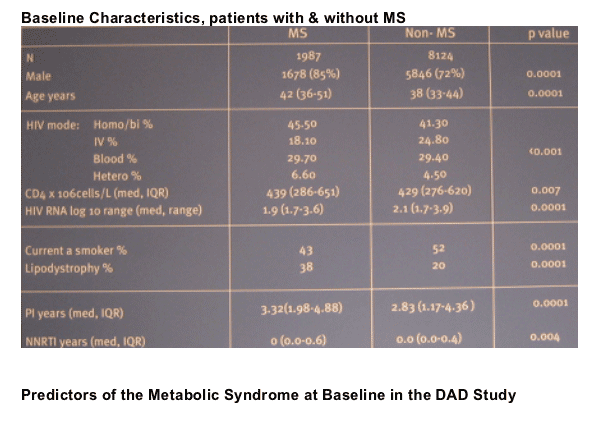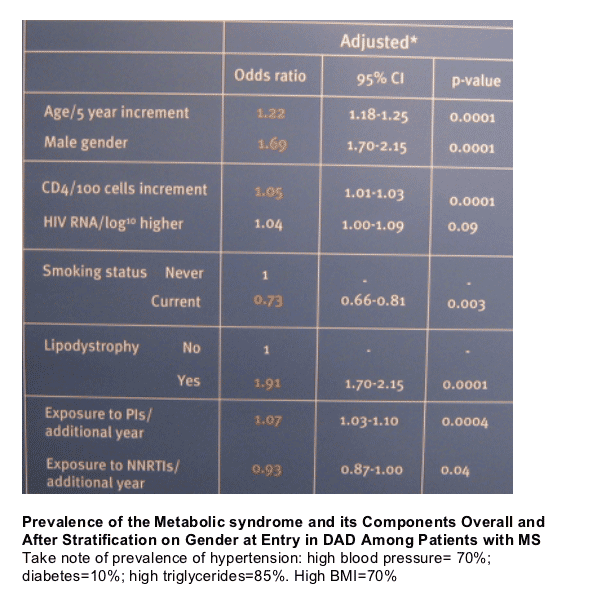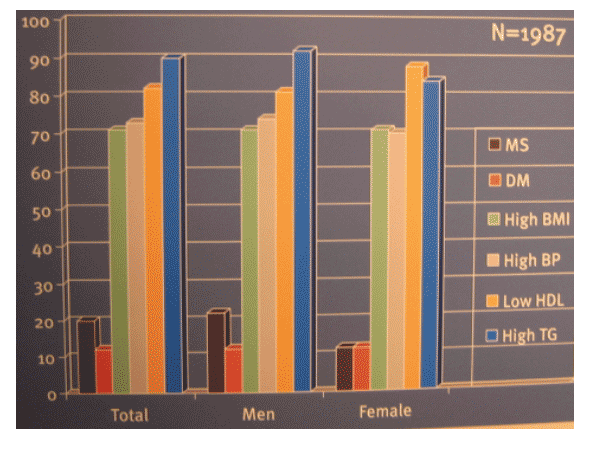 |
 |
 |
| |
The Metabolic Syndrome at Baseline in the D:A:D study 20%
|
| |
| |
Reported by Jules Levin
8th Intl Congress on Drug Therapy in HIV Infection
Signe Worm, C Sabin, W El-Sadr, P Reiss, A Monforte, M Rickenbach, R Thiébaut, S de Wit, E Fontas, M Law, O Kirk, J Lundgren, N Friis-Moller. Copenhagen HIV Programme (CHIP), Hvidovre University Hospital, Hvidovre, Denmark
Purpose of the Study To investigate the prevalence and key components of the metabolic syndrome (MS) in HIV-infected persons.
DAD is a prospective, observational cohort study following >33,000 HIV+ patients from Europe, Australia and the USA. 10,111 patients with complete baseline measurements on the risk factors in the MS definition were included in a cross-sectional analysis of the prevalence of the MS and components. The MS was defined by using modified NCEP ATPIII criteria, ie the presence of 3 or more from the list below.
In the study population (n=10,111) 20% fulfilled the NCEP definition for MS. MS leads to a 2-fold higher risk of cardiovascular diseases in the general population. Components of the metabolic syndromes includes elevated triglycerides, low HDL, hypertension, hyperglycemia, and abdominal obesity. In HIV, the relative contribution of the risk factors defining MS is thought to differ from the general population. MS is closely associated with insulin resistance and has several features in common with lipodystrophy. The aim of this study is to investigate the baseline prevalence of the syndrome and factors associated with MS in HIV-infected individuals.
OBJECTIVES
To investigate the baseline prevalence and predictors of the MS by using the American NCEP ATPIII guidelines (National Cholesterol Education Panel, Adult Treatment Panel III (2) among patients at entry in to the D.A.D. Study.
The presence of >3 of the following defined MS (*Modified NCEPIII criteria):
-- HDL cholesterol (HDL)<1,0 mmol/l (men),<1,3 mmol/L (women).
-- Triglycerides (TG)>1,7 mmol/L.
-- Hypertension (HYP) blood pressure >130/85 mm Hg.
-- Diabetes mellitus (DM),*replacing impaired glucose tolerance.
-- Body-mass index (BMI)>25 kg/m2,*replacing waist circumference.
Factors independently associated with the presence of MS at baseline were assessed from a logistic regression model, that included baseline values of: gender, age, cumulative exposure to protease inhibitors (PIs), cumulative exposure to NNRTIs, smoking status, CD4+ lymphocyte count, HIV RNA, physician defined lipodystrophy, and cohort.
RESULTS
Metabolic Syndrome
In the study population (n=10,111) 20% fulfilled the NCEP definition for MS.
The patients with MS were significantly older than patients without MS.
Cigarette smoking (current) was higher in the patients without MS (53% vs 43% p=0.0001). Lipodystrophy was more common among patients with MS, 38% vs 21% in those without MS (p=0.0001). there were differences in the two groups in exposure to ART, with more PI experience in the MS group compared to the no-MAS group (table 1).
Gender and age
Men had a higher prevalence of the syndrome than women, with a prevalence of 22% compared to 12% in women. The prevalence of each of the components of the MS as well as the overall prevalence of MS in men and women, are illustrated in Figure 1.
Factors independently associated with MS at baseline
After adjustment, the strongest relationships were seen with lipodystrophy (Odds Ratio [OR] 1.91 [95% Confidence interval 1.70-2.15]), male gender (1.76 [1.53-2.01]), and age (OR 1.22 (1.18-1.25) per 5 years increment. Table 2.
Other independent predictors were exposure to PI (OR 1.07 [1.03-1.10]), CD$ lymphocyte count per 100 cells/uL increment (OR 1.02 [1.01-1.03]), and HIV RNA per log10 higher (OR 1.04 [1.00-1.09). There was a borderline significant association with NNRTI in the adjusted model (OR 0.93 [0.87-1.00, p=0.04]). There was a borderline significant association with NNRTI in the adjusted model (OR 0.93 [0.87-1.00, p=0.04]). Smoking was associated with a decreased risk of MS (OR 0.73 [0.66-0.81]).
DISCUSSION
The prevalence of MS among 10,111 HIV+ was 20% at baseline in the D.A.D. study, 22% in men and 12% in women. This is similar to what is found in non-HIV populations at similar ages. The size of this prevalence is also comparable to previous findings in HIV+ populations.
The relative contribution of components of the MS differ from what has been described in the general population, with dyslipidemia (high triglycerides and low LDL) and hypertension being the most prevalent components in HIV+ rather than abdominal obesity and impaired glucose tolerance.
Host factors such as age and male gender were associated with MS to a similar extent as in the general population. Smoking was associated with a lower prevalence of MS, possibly as a result of smoking known to be associated with lower BMI.
Treatment related predictive factors in this study included PI exposure and lipodystrophy. Lipodystrophy might be phenotypically linked to MS, with central fat accumulation, and associated changes in fat and glucose metabolism. The association between PI as an independent risk factor for the metabolic syndrome is not surprising, since PIs are known to cause dyslipidemia and changes in glucose homeostasis.
PERSEPECTIVES
Studies within the D.A.D. will explore the incidence of MS over 7 years of follow-up and is investigating whether the concept of the MS results in a better prediction of CVD than inclusion of the individual risk factors in a standard multiplicative model. These analyses wil seek to identify specific interactions between the individual risk factors.
(1) Dekker JM et al. Circulation 2005 Aug 2;112(5):666-73.
(2) Executive Summary of the third report of the national cholesterol education program (NCEP) expert panel on detection, evaluation and treatment of high cholesterol in adults (Adult treatment III). JAMA 2005;285(19):2486-97.



|
| |
|
 |
 |
|
|